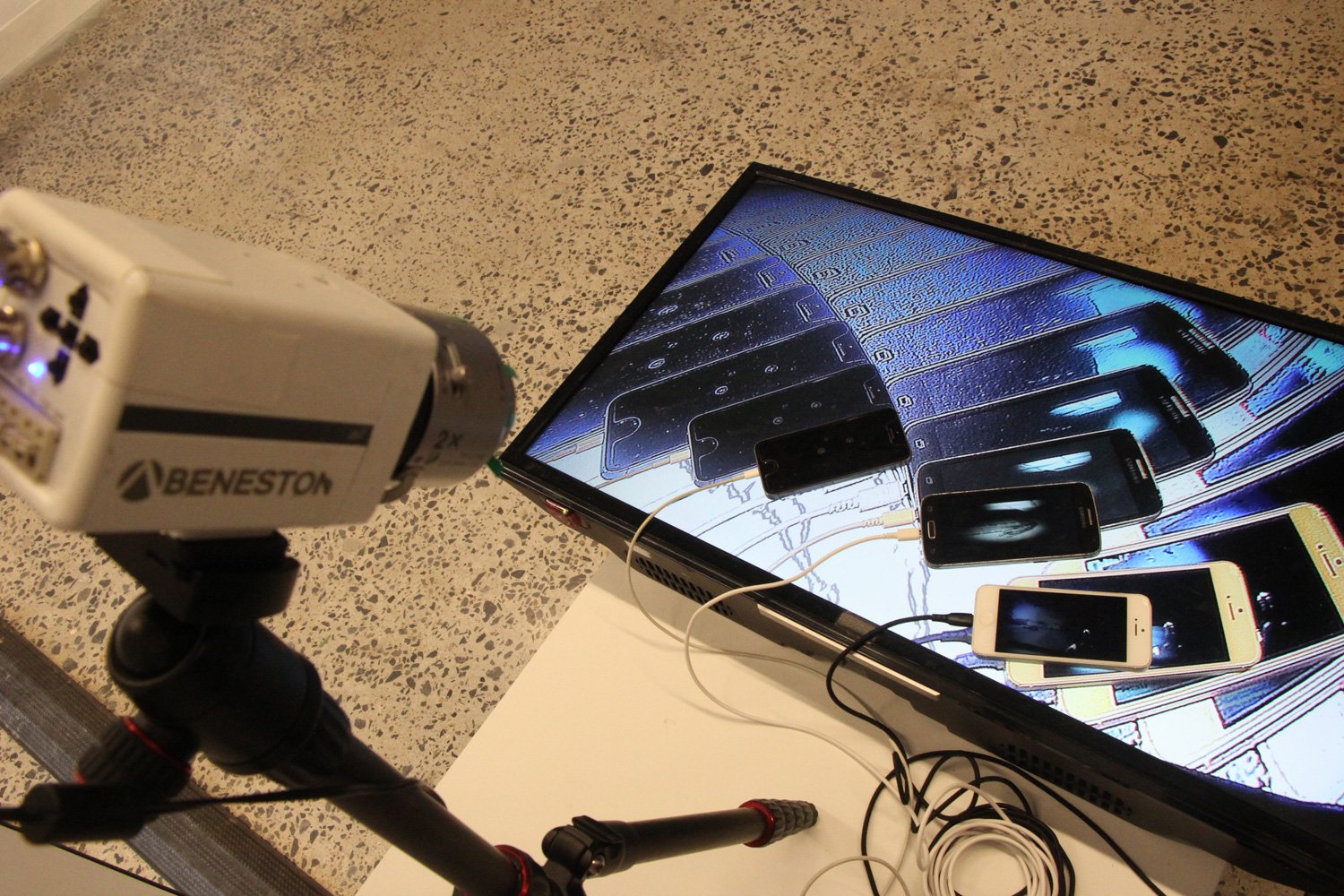Static Age (Innerventions 1-10) is a video series composed of ten virtual sketches using found imagery as its basis. Presented as an installation, three edits of the video are displayed on separate iPhones atop an LCD monitor connected to a colour CCTV camera facing the screen. The effect is an internal feedback loop where the imagery of the three cell phones are redisplayed in a cascade towards infinity. The effect is playful and inviting for direct engagement by the audience via manipulating the cellphones along the screen’s surface. The installation is in constant manifestation, potentially reacting to audience intervention at any instant throughout.
All sampled footage is recorded externally twofold through my camera from a computer monitor. By using an array of pinhole cards overtop of my camera lens I am able to selectively recapture pieces of imagery from found sources. This imagery is then ran through two algorithmic editing systems: (1) An automatic editor, which (re)determines playback placement, duration, and positionality for each individual file on a frame-by-frame basis. (2) A frame trailer, which retains the visibility of all previous frames in a video file for a given duration. The finished project is a dense yet intuitively random collage. By serially repeating brief instances through automatic editing, I am able to break any internal spacetime relations left over from the sample footage. Albeit, I attempt to use this selectively; leaving some pieces’ linear integrity intact. Once the parameters for each clip are set, I begin recording externally a second time. By allowing my camera to sit, watching the algorithm work with a video file for long periods, a certain analytical insight opens up. One sees the unseen: what was already there but lying just beneath the surface. By now the footage has lost much of it’s high definition quality, becoming blurred and showing traces of the LCD monitor. It is at this point that the footage is imported into an NLE software and collaged together based on content and composition. Upwards of three layers are used at any time combining disparate pieces into a cohesive poetic visualism. Through these techniques I am positioning myself as a virtual scavenger, able to link together disparate pieces of found footage into an infinite sample-based practice. This series also features a few light performances and feedback loops. For these I am focusing my attention on the camera apparatus and LCD monitor as recording mediums. I perform with a high powered flashlight directed at a cheap webcam, attempting to create expanded light events by tampering with the recording medium’s limitations. I create a feedback loop by focusing my camera at a connected LCD monitor. By maneuvering the camera apparatus in different ways in relation to the screen I am able to manipulate the chaotic feedback loop. These are performances for camera that use it’s apparatus as the central object.
My practice has always dealt with the ephemeral medium of video. A medium whose presence, unlike other mediums, necessitates supplementary electronics. This offers doubly a problem and a solution: How does(n’t) one present a work of video art in a gallery setting? Before settling on any idea, I knew I wanted an open configuration that would invite audience recomposition. I wanted to emphasize the piece’s constant manifestation. I decided to lean into the open-endedness of video by latching hold of the roots of inspiration for the piece: the screen. The collages themselves, prior to any exhibition plan, engage with the screen as a major homogenizing force for interweaving footage. They attempt the resurrection and repotentialization of video artifacts found online by recompositing them together anew as a collage through the screen. So to multiply the work on three cell phones amidst a feedback loop made perfect sense. In doing so I was highlighting the process of the piece's creation within its exhibition. I see the use of cellphones in a feedback loop as a reflection of online echo chambers, conspiracy theories, and algorithmic gatekeeping. All of which are themes dealt with in the films themselves as I scoured the internet for imagery to recomposite. I want to thank Samuel Meech and the IMCA depot who greatly assisted this work.


